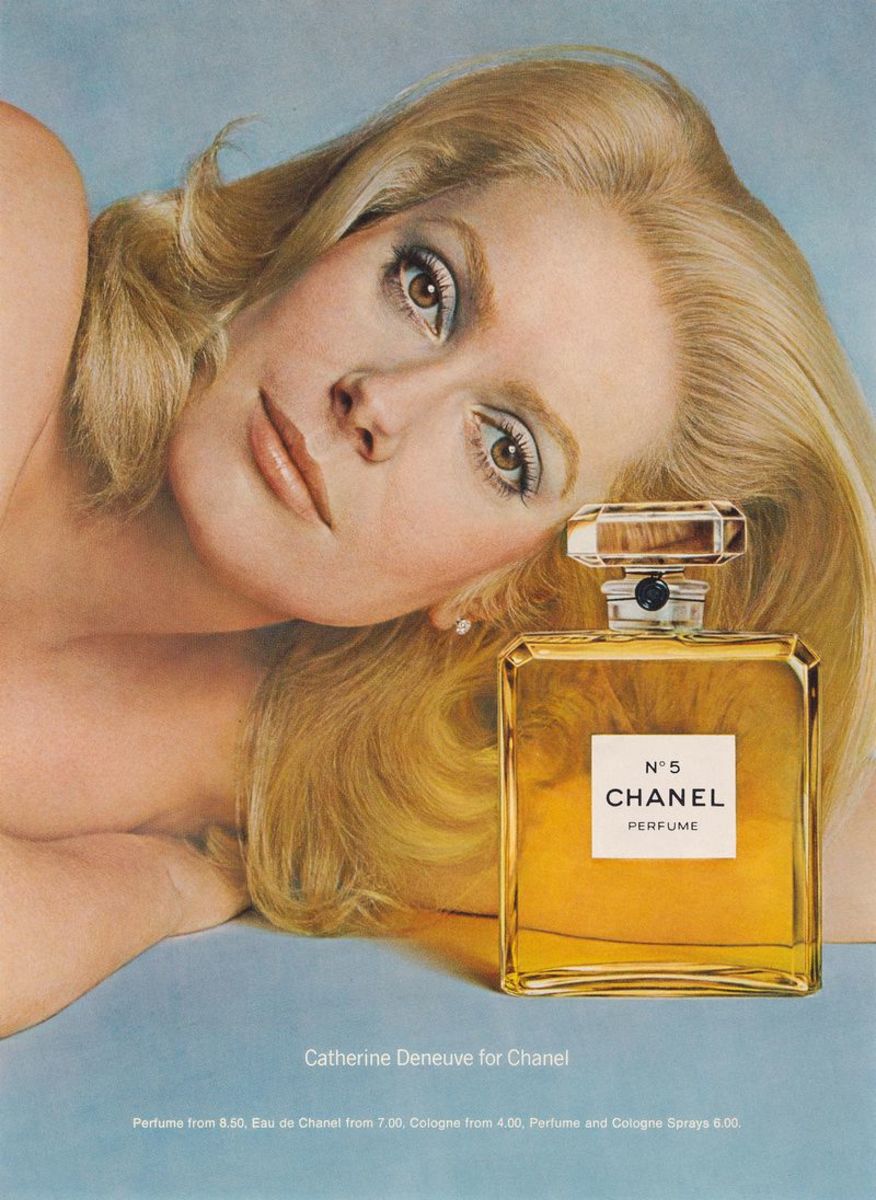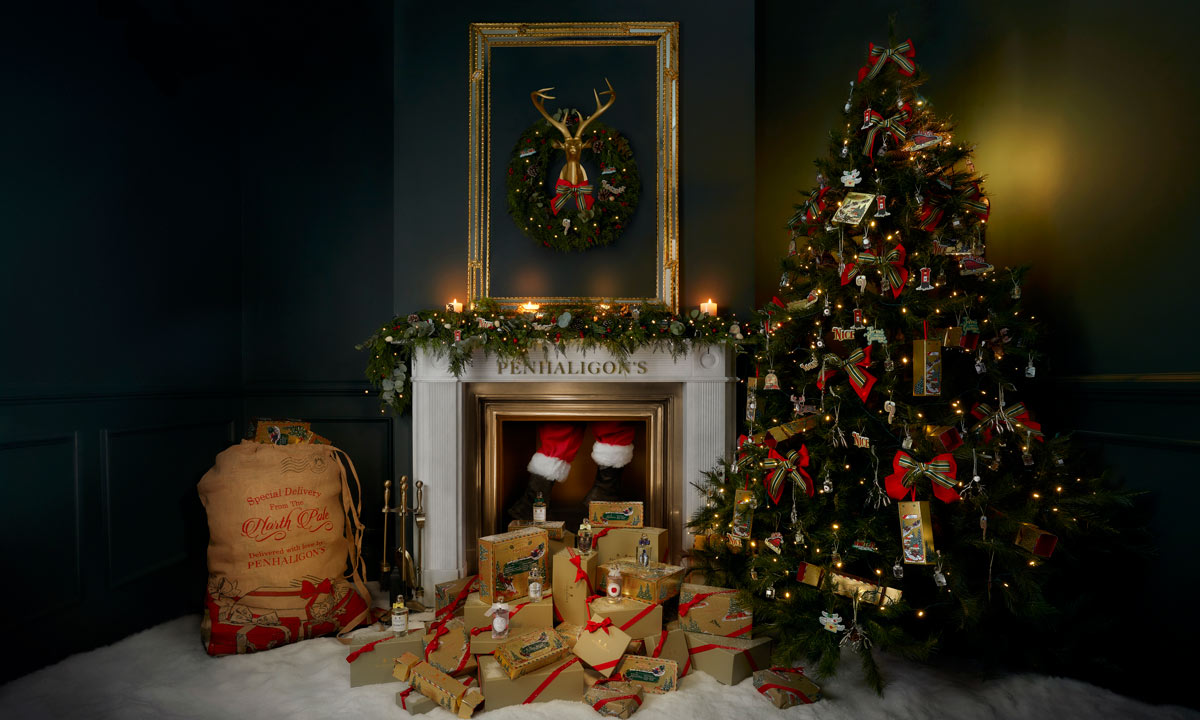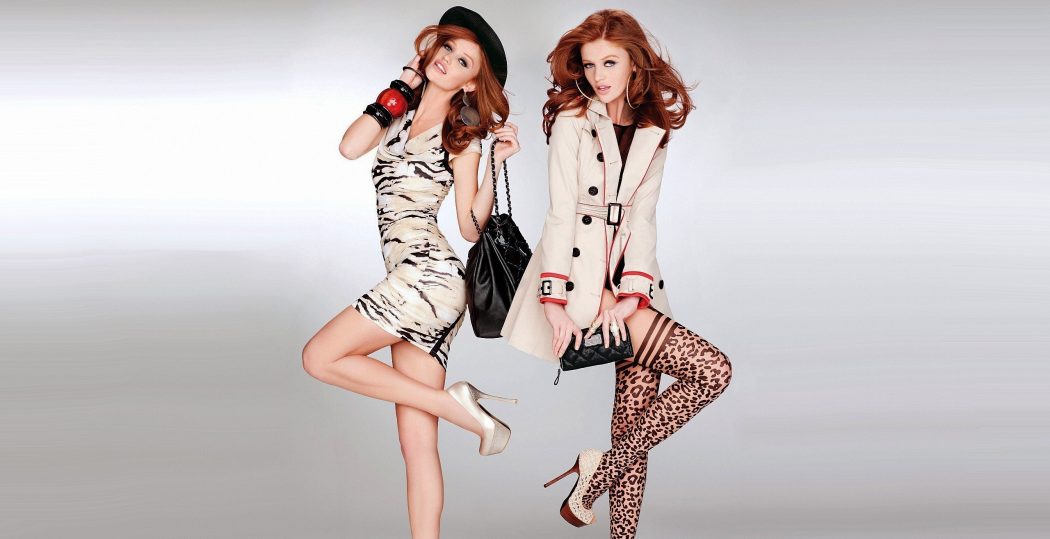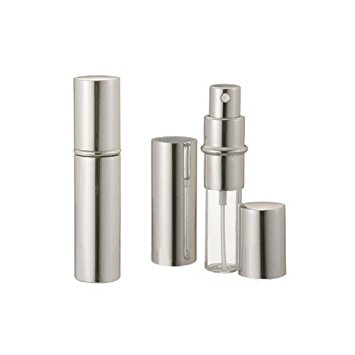

Catherine Deneuve appears in a 1975 Chanel No. 5 campaign. Photo: Courtesy of the Richard Avedon Foundation
Welcome to Fashion History Lesson, in which we dive deep into the origin and evolution of the fashion industry’s most influential and omnipresent businesses, icons, trends and more.
Earlier this year, Chanel released a new scent: Chanel No. 5 L’Eau, which the brand describes as a “modern, fresh and vibrant embodiment of the now and forever scent,” or “the No. 5 of today.” The marketing campaign employs 17-year-old actress, model and social media “It” girl Lily-Rose Depp (daughter of Johnny Depp and Vanessa Paradis), whose waifish figure and doe eyes starkly contrast the mature sophistication that’s often associated with the original No. 5. This intentional departure was reflected in Chanel’s social media as they teased the full campaign. Clashes of images were selected to represent “modern paradoxes”: disorder/order, masculine/feminine, unique/multiple, pure/artificial and perhaps the one mostly closely related to the story of Chanel, truth/lies. The tagline “the scent of all paradoxes” and accompanying slogan “#youknowmeandyoudont” tells the world that women are dichotomous creatures that can be many things at once. However, the slogan also serves as an apt descriptor of the enigmatic Gabrielle “Coco” Chanel, who managed to build her long-lasting reputation as the arbiter of chic largely around myths and clever marketing opportunities.
Like most things credited to the genius of Gabrielle “Coco” Chanel (tanning, little black dresses, etc.), the inception of Chanel No. 5 is primarily based on stories that are difficult to prove. In fact, the brand’s website emphasizes the fabled history of the perfume, stating that the new No. 5 “rewrites the myth with audacity to transform a heritage into a contemporary tale.”
So, considering the brand takes pride in the paradoxes and mythical nature of the perfume, what parts of the history of Chanel No. 5 are real? From what historians have uncovered, the real story is complicated and controversial. Here, we take a look at just some of the factors that have contributed to the perfume’s unprecedented success — and the paradoxes that defined the woman behind it.

Gabrielle Chanel in a 1937 Chanel No.5 campaign originally published in “Harper’s Bazaar.” Photo: François Kollar/Ministère de la Culture Médiathèque du Patrimoine RMN
CREATING A LEGEND
Up until the 20th century, a perfumer crafted scents while fashion houses stuck with clothing. Although some designers began to dabble in scent production in the early 1900s, French couturier Paul Poiret, one of Chanel’s greatest and nastiest rivals, is generally credited with being the first to introduce a signature fragrance in 1911. However, Poiret named it Parfums de Rosine after his daughter instead of using his own name. [1] On the other hand, Chanel placed her name prominently on every bottle and advertisement related to her fragrances, ensuring that her perfumes would always be linked to her brand identity.
The origin legend of Chanel No. 5 usually begins with Chanel meeting French-Russian perfumer Ernest Beaux in 1920 and challenging him to create a scent that would make its wearer “smell like a woman, and not like a rose.” Apparently, Chanel thought women smelled like a mixture of 80 natural and synthetic ingredients, because that’s what she chose when Beaux presented her with a numbered series of perfume samples to choose from. As legend goes, Chanel picked the fifth sample, declaring, “I show my collections on the fifth of May, the fifth month of the year, so let’s leave the number it bears, and this number five will bring it good luck.” [2] The chosen formula, which debuted in 1921, was an olfactory bouquet of notes that include jasmine, ylang-ylang, may rose and sandalwood, along with a generous dosage of aldehydes that give the perfume its distinctive “clean” scent, reminiscent of fresh laundry.
Traditionally, respectable women wore perfumes that smelled like singular flowers while courtesans and other racy ladies stuck to more brazen smells such as musk or jasmine to attract men. By choosing a scent that blended the sensual allure of jasmine and musk with indefinable flowers and aldehydes, Chanel made a scent that questioned the notion of perfume indicating social standing, helping to demonstrate the paradox — voilà! — that women could be simultaneously “sexy” and “pure.” Additionally, it’s no secret that Mademoiselle Chanel was once a kept women who used money from her lovers to help fund her business ventures. Considering that, her opinions on sexuality and female empowerment were considered unconventional at the time, which make the characteristics of Chanel No. 5 seem all the more fitting.
The perfume’s strong percentage of aldehydes allowed the fragrance to linger on the wearer’s skin for an extended period of time, making it more suitable for “modern” women with busy lives and complex tastes. However, some historians consider Jicky by Aimée Guerlain, released in 1889, to be the first modern perfume. Instead of imitating the smell of flowers, Jicky was also a combination of natural and synthetic ingredients that created a scent that was multifaceted and unlike anything found in nature, predating the “revolutionary” concept of Chanel No. 5 by over 30 years. [3]
MARKETING
Surprisingly enough, the early success and meteoric rise of Chanel No. 5 had little to do with marketing, despite the fact that the perfume was later featured in some of the most memorable advertising campaigns of the past century.
Although the perfume was featured in glamorous advertisements throughout the 1940s and 1950s, using taglines like “Every Woman Alive Loves Chanel No. 5,” perhaps the most iconic campaign featured Catherine Deneuve in the 1970s. Shot by Richard Avedon, the advertisement is as minimal as the perfume packaging itself, featuring nothing but the French actress’s name and face along with the perfume bottle. Deneuve would set the stage for a long line of gorgeous actresses to rep the perfume, including Nicole Kidman, who was featured in the expensive and extravagant No. 5 commercial directed by Baz Luhrmann in 2003. In a strange twist, Chanel enlisted actor Brad Pitt to be the first male to advertise Chanel No. 5 in 2012, which resulted in one of the most bizarre beauty commercials that we’ve ever seen.
Perhaps the best publicity that Chanel No. 5 ever received was not an advertisement at all. Who can forget the legendary Marilyn Monroe response when a reporter asked her what she wore to bed? From that moment on, nothing could be sexier than the idea of a woman wearing just a few drops of Chanel No. 5 to bed. The brand decided to reuse this iconic line in 2013 when they based a new campaign around the sound clip and classic images of the starlet holding the perfume bottle provocatively by her chest.
CONTROVERSY
So, let’s be real: Not everything about the history of Chanel No. 5 is sexy, and it’s no secret that Mademoiselle Chanel had some very questionable opinions and alliances throughout her lifetime. Some of these controversial traits are made evident by her relationship with Pierre and Paul Wertheimer, who financed Parfums Chanel. In 1924, Mademoiselle Chanel entered into an agreement that removed herself from involvement in all fragrance business operations, providing her with 10 percent of all French sales in exchange for licensing her name. Realizing the true money-making potential as Chanel No. 5 quickly became a best-selling perfume, Chanel fought to regain control of her fragrance line, and would do so for decades to come. [4]
An opportunity to seize control presented itself at the onset of World War II, when the fragrance was being manufactured in Hoboken, NJ using materials imported from France. Since the Wertheimer brothers were a Jewish family, their business and ownership was susceptible to Nazi seizure. In 1941, Chanel supposedly wrote to German officials in an attempt to use her “Aryan” position as a way to regain sole ownership of her fragrance line from “the property of Jews.” [2] Much to her surprise, the brothers had cleverly turned ownership over to a Christian businessman before the onset of Nazi control, which made Chanel’s plea a failed attempt. After the war, the brothers were given back their ownership, and renegotiated their agreement with Chanel to grant her two percent of worldwide perfume sales worldwide, making her one of the richest women in the world. [4]
POPULARITY TODAY
Part of Chanel No. 5‘s enduring success stems from its status as an “aspirational purchase,” which allows women of different income levels to get a “whiff” of the wealth and exclusivity that the Chanel brand continues to represent.
According to Olivier Polge, creator of Chanel Fragrances, No. 5 L’eau “pays homage to the original but feels more youthful.” In many ways, that quote could be used to describe everything that the Chanel brand does today, thanks in part to Creative Director Karl Lagerfeld’s ability to tap into youth and celebrity culture. The brand continuously reworks classic Chanel tropes (tweed suits, pearls, black dresses, etc.) for younger markets by incorporating contemporary styles and employing young celebrity spokespeople (like one Lily-Rose).
The Chanel brand itself is remarkably good at telling stories that reinforce Mademoiselle’s Chanel’s mythical aura. They’ve even released a video titled “The Self-Portrait of a Perfume,” where the narrator (a.k.a Chanel No. 5) says, “I am a consciousness, a way of walking, of thinking, of dreaming, of being true to one’s self.” Considering that the perfume is branded as a way of life rather than a luxury product, it’s no wonder that it’s continued to be popular with a wide range of age groups for over 90 years.
All things considered, can No. 5 L’Eau really “rewrite a masterpiece”? Probably not, but that doesn’t mean that Mademoiselle Chanel wouldn’t have approved of this emphasis on appealing to the lives and interests of the “modern woman,” even if the “modern woman” happens to be a 17-year old Instagram star.
Sources Not Linked:
[1] Green, Annette. “Perfume.” In The Berg Companion to Fashion, edited by Valerie Steele. London: Berg, 2010.
[2] Mazzeo, Tilar. The Secret of Chanel No. 5: The Intimate History of the World’s Most Famous Perfume. New York: HarperCollins, 2010.
[3] Moeran, Brian. “Fragrances and Perfumes.” In Berg Encyclopedia of World Dress and Fashion Vol. 8: West Europe, edited by Joanne B. Eicher (volume edited by Lise Skov). London: Berg, 2011.
[4] Thomas, Dana. “The Power Behind the Cologne.” New York Times. February 24, 2002: 62.
Other posts : [wpb-random-posts]




